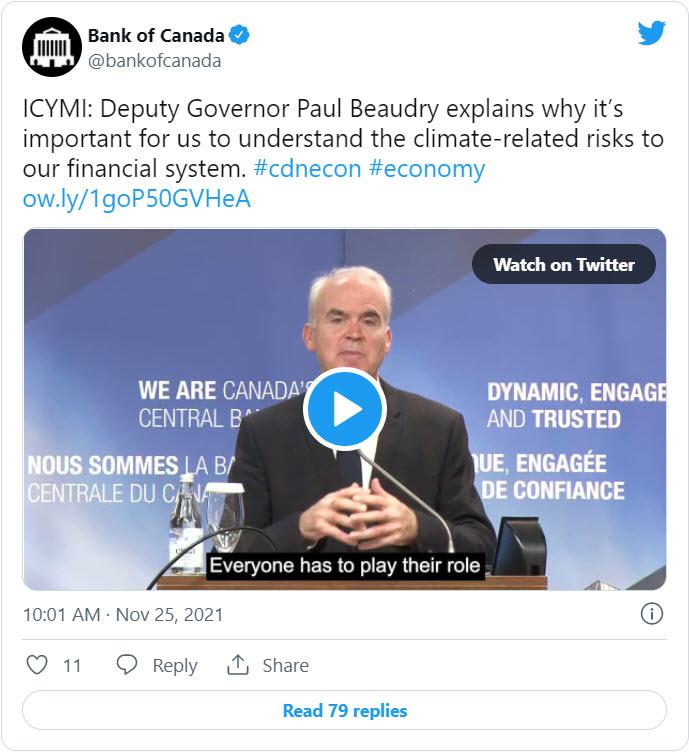
Advancing the Bank’s climate change work
Climate change poses significant risks to the economy and financial system. In 2021, the Bank deepened its understanding of these risks and continued its efforts to reduce its carbon footprint and manage climate-related risks to its operations.
The Bank announced its climate change commitments as the 2021 United Nations Climate Change Conference (COP26) was unfolding in Glasgow, Scotland.1
ICYMI: Deputy Governor Paul Beaudry explains why it’s important for us to understand the climate-related risks to our financial system. #cdnecon #economy https://t.co/DHXsPdMNdO pic.twitter.com/MH8IwlUSYQ
— Bank of Canada (@bankofcanada) November 25, 2021

https://twitter.com/bankofcanada/status/1463885509487480832
Fulfilling the Bank’s mandate in a changing climate
Climate change has implications for the Bank’s mandate. In 2021, the Bank devoted significant resources to assessing these implications.
Exploring how climate change could affect the economy and price stability
Bank staff continued to research how climate change and transitioning to a low-carbon economy could affect:
- the economy
- inflation
- jobs
This work included developing Canadian macroeconomic scenarios, which are useful for identifying potential risks in an environment of considerable uncertainty.
The Bank also began integrating climate considerations into its macroeconomic simulations. This helped the Bank better define what climate change might mean for the Canadian and global economies. In undertaking this cutting-edge work, the Bank became the first central bank to assess transition risks by combining climate-economy models with macroeconomic models.
Gauging how climate change could affect the financial system
Climate change also poses important risks to individual participants within the financial system as well as to the overall stability of the system. Physical climate risks from extreme weather events can expose households to financial stress, especially households that are already financially vulnerable.
The 2021 Bank of Canada Financial System Review summarized research that combined data on regional exposure to climate-related natural disasters with data on the geographic distribution of household financial vulnerabilities. This work helped researchers recognize how climate-related natural disasters—depending on where they occur—can have varying implications for the economy and financial system.
The transition to a low-carbon economy also poses climate risks to the financial system. Because asset prices may not correctly reflect these risks, they are subject to potentially large repricing.
The Bank worked with the Office of the Superintendent of Financial Institutions and six Canadian financial institutions to complete a pilot project that used climate scenarios to assess transition risks.2
The project successfully met its goals to:
- increase understanding of the financial sector’s potential exposure to climate transition risks
- help the Canadian financial sector improve its assessment and disclosure of climate-related risks
- build the capability of financial institutions and authorities to conduct climate scenario analysis
The project also improved authorities’ understanding of the practices that financial institutions have put in place to govern and manage risks and opportunities related to climate change.
The Bank’s scenario work was part of a global effort. Many central banks and supervisors that, with the Bank, are members of the Network for Greening the Financial System conducted similar climate scenario exercises in 2021.
We recognize the importance of including #climatechange considerations in our work to promote the economic and financial welfare of Canadians. Read our pledge. #cdnecon #economy #COP26 https://t.co/Y12kKYVlno
— Bank of Canada (@bankofcanada) November 3, 2021

https://twitter.com/bankofcanada/status/1455878701971816448
Contributing to international dialogue on climate risks
In 2021, leaders from around the world renewed their commitment to tackling climate change. The Bank played a key role in many important discussions.
For the first time, both the G7 and G20 presidencies included climate action among their top global policy priorities. Central bank governors agreed that more systematic analysis is needed to assess macroeconomic risks stemming from climate change. They also committed to analyzing the costs and benefits of different paths to achieving net-zero emissions in greater detail.
The Bank actively contributed to this dialogue and regularly collaborated with many international partners on these issues:
- The Bank sits on the steering committee for the international Central Banks and Supervisors Network for Greening the Financial System. In this role, the Bank helps guide the network’s efforts, particularly those related to evaluating the impacts of climate transition on countries with large resource sectors, such as Canada. The Bank used its influence and expertise in this area to promote a scenario-based approach to the disclosure of climate-related risks.
- The Bank also worked with other international bodies, including the Financial Stability Board (FSB). It played an important role in the FSB’s work on climate-related financial risks.
- As a member of the G20 Sustainable Finance Working Group, the Bank contributed to a sustainable finance roadmap. The roadmap establishes a plan for ramping up the sustainable finance needed to speed up the implementation of the Paris Agreement from both private and public sources.
“LEED Gold to be achieved through a 50-year-old all-glass building is a huge endeavour.” Check out this @CentralBanking_ article to learn about some of the changes we’ve made to reduce our carbon footprint @USGBC #cdnecon #economy https://t.co/Zj7UAuxnEp
— Bank of Canada (@bankofcanada) May 5, 2021

https://twitter.com/bankofcanada/status/1389943527241654274
Reducing the Bank’s environmental footprint
In 2021, the Bank continued to take important steps to:
- measure and reduce its own carbon footprint
- integrate climate change into planning and decision making
To fulfill its 2020 commitment to achieving net-zero operational carbon emissions by 2050, the Bank identified the primary operational areas to be targeted. It also established preliminary action plans for their decarbonization, including a roadmap for reducing emissions in its facilities by:
- 40% by 2025
- 80% by 2030
The Bank also completed site assessments of all the buildings it owns. These assessments will be followed by environmental engineering studies to identify opportunities for significant improvements in energy, waste and water consumption. In addition, the Bank signed an agreement with a clean energy provider to shift to 100% renewable electricity in 2022.
The Bank committed to:
- achieving near-zero water consumption across the buildings it owns by 2035 or sooner
- achieving near-zero waste across the buildings it owns, diverting 75% of operational and plastic waste and 100% of construction waste by 2030
It is also working to integrate environmental, social and governance principles into managing the Bank of Canada Pension Plan.
#EarthDay reminds us that the natural #environment is a defining feature of our economic prosperity. Learn about the changes we’ve made to our operations to reduce our carbon footprint. #cdnecon https://t.co/AEJfhDEfbY pic.twitter.com/LP9lTjCrga
— Bank of Canada (@bankofcanada) April 22, 2021

https://twitter.com/bankofcanada/status/1385217434064408582
Disclosing exposures to climate-related risk
Like all organizations, the Bank faces a variety of risks associated with climate change.
In 2021, the Bank began developing a framework to measure and report its own exposure to climate-related risk. This framework will enable the Bank to more comprehensively assess risk exposures and is aligned with the recommendations of the Task Force on Climate-Related Financial Disclosures.
In 2022, the Bank will begin work on reporting its climate-related financial risks. It will use its climate risk framework and draw on best practices and the experiences of other central banks to draft its report. These are described in the Network for Greening the Financial System Guide, which the Bank contributed to in 2021. The Bank hopes that publication of this report encourages other financial institutions to disclose their own exposure to climate risks.
Looking forward
In 2022, the Bank will:
- continue to assess the economic and financial effects of climate risks
- contribute to the work of the Network for Greening the Financial System, focusing on:
- refining and promoting the use of climate-change scenarios for the disclosure of climate risks
- identifying and addressing data gaps
- providing advice on best practices for market transparency related to climate change
- continue to steer the global policy dialogue on climate change
- implement decarbonization action plans for targeted operational areas, including:
- completing environmental engineering studies of all Bank-owned buildings and addressing immediate opportunities
- embedding sustainability considerations into procurement processes
- establishing baseline metrics for greenhouse gas emissions, water consumption and waste for bank note operations
- launching an education and awareness program about business travel and commuting to work
- work toward publishing a report that follows the recommendations of the Task Force on Climate-Related Financial Disclosures
- analyze, including through consultations, options for integrating climate change considerations in the design of market operations
- 1. Bank of Canada, “Bank of Canada Announces Climate Change Commitments for COP26” (press release, November 3, 2021).[←]
- 2. Bank of Canada, “Assessing Climate Change Risks to Our Financial System” (January 14, 2022).[←]